Horns, Tusks, and Value
In the last chapter, we saw that horn length is used to evaluate the age and worth of a buffalo offered for sacrifice at a feast. This worth, however, seemed disproportionate, both to the amount of meat on the animal and to the number of other young animals offered in exchange. The logic of "horn counting" must be explained in greater detail, for in fact it does represent a relatively precise measurement, not only of the age of the animal, but also of its value in terms of an investment in time.
In buffalo, horns begin to grow toward the end of the first year and continue at a fairly even rate for twenty or thirty years. The Kodi term for a yearling does not refer directly to age, but to the newly budding horns: it is "the budding of a bull" (kamboka ghobo ) or, in ritual couplets, hanjoko wu kawallu, hinjalu watu kamba —"just a candlenut bump of horn, one node of cottonseed." A yearling is also referred to as hinjalu mete mata , "one node with black eyes" marking the darkness of eyes that grow paler with age.
Horn size is measured along the right arm. An outsider watching two men bartering the exchange of buffalo or discussing a feast slaughter might assume that they were talking about glove lengths instead of livestock, as their hands keep moving up and down their arms. The index finger is placed at various points between the fingertip and the armpit, usually preceded by an apology in Indonesian ("permisi ") for the indelicacy of
pointing. Common measurements are at the finger joint, the base of the thumb, wrist, mid-forearm, elbow, mid-bicep, and the armpit. When a promised animal is finally presented, the estimated horn length may be verified by stretching the arm along the horns, fingertips resting at the skull and the tip of the horns determining the final measure.
The practice of using horns and tusks to indicate value of some sort is quite widespread. In other areas of Indonesia where buffalo sacrifice is highly developed, such as Toradja, the display of the horns is also commonplace (Volkman 1985)· In the "pig-loving" areas of Melanesia, where prestige exchanges center on that animal, a similar cultural significance is given to pig's tusks. Special "tusker" boars are created by invulsing the upper canines and allowing the lower ones to grow unimpeded, so that the animal's tusks form a perfect circle (Jolly 1984).[1] Sumbanese perform a related operation on gelded buffalo (mandopo ), whose horns subsequently make the most impressive house decorations. After gelding, a buffalo's horns grow so long they may threaten to pierce the skull; hence, the horns of a gelded yearling are heated and forcefully twisted away from the head to form a large arc like that of long-horned cattle. The Sumbanese, who find aesthetic pleasure in contemplating an impressive spread of horns, boast that after this operation some animals' horns grow all the way to the ground, forcing them to walk about with permanently bowed heads. Indeed, many older gelded animals cannot be taken to pasture and must be hand-fed with grass at the back of the house.
Gelded buffalo form a special category in Kodi sacrifices. Although the most prestigious gift is an older bull, the distinctive mandopo may be preferred when the donor wants his gift to be singular and unforgettable. In theory, a very long-horned buffalo can be reciprocated only by another rnandopo . Horn length used as a criterion of value in buffalo is paralleled by tusk length used to determine the value of pigs.
[1] The particular value of the tusker is variable in Melanesia. In Malekula, Vanuatu, value "resides not so much in the flesh of the animal as in its tusks" as "most boars sacrificed are so old and scrawny as to be inedible" (Jolly 1984, 85). Once the tusks are separated from the animal, however, they lose their value. In South Pentecost, the tusks are kept as ritual mementos of the glory of past grade-taking rituals; and in the Massim area they circulate as kula valuables and are mystified as "snakes' teeth" (Jolly 1984). Although the tusks are believed to have magical and mystical powers, the animals that grow them are clearly incapacitated; the tusker becomes unable to scavenge on its own and must be hand-fed. In Malekula, long-tusked pigs are the prize possessions of men, while other pigs are tended by women.

A young man dances as he leads a long-horned buffalo, around twenty-five
years old, onto the slaughter field at a large-scale feast. The gift of the buffalo
fulfills an affinal obligation from a wife-taker. 1984. Photograph by the author.